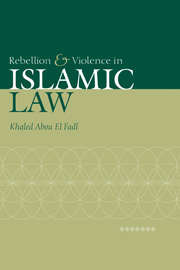Book contents
- Frontmatter
- Contents
- Preface and acknowledgments
- Introduction
- 1 Modern scholarship and reorienting the approach to rebellion
- 2 The doctrinal foundations of the laws of rebellion
- 3 The historical context and the creative response
- 4 The rise of the juristic discourse on rebellion: fragmentation
- 5 The spread of the Islamic law of rebellion from the fourth/tenth to the fifth/eleventh centuries
- 6 Rebellion, insurgency, and brigandage: the developed positions and the emergence of trends
- 7 The developed non-Sunnī positions
- 8 Negotiating rebellion in Islamic law
- Works cited
- Index of names
- Index of subjects
6 - Rebellion, insurgency, and brigandage: the developed positions and the emergence of trends
Published online by Cambridge University Press: 15 December 2009
- Frontmatter
- Contents
- Preface and acknowledgments
- Introduction
- 1 Modern scholarship and reorienting the approach to rebellion
- 2 The doctrinal foundations of the laws of rebellion
- 3 The historical context and the creative response
- 4 The rise of the juristic discourse on rebellion: fragmentation
- 5 The spread of the Islamic law of rebellion from the fourth/tenth to the fifth/eleventh centuries
- 6 Rebellion, insurgency, and brigandage: the developed positions and the emergence of trends
- 7 The developed non-Sunnī positions
- 8 Negotiating rebellion in Islamic law
- Works cited
- Index of names
- Index of subjects
Summary
The cAbbāsid caliphate was formally extinguished by the Mongols when they sacked Baghdād in 656/1258. Two centuries earlier, the caliphate had fallen under the strong influence of the Seljuk princes who seized Baghdād from the Buwayhids in 447/1055. But, as noted earlier, the cAbbāsid caliphate had become weakened to the point of impotence in the fourth/tenth century. The weakening and eventual extinction of the cAbbāsid caliphate posed a fundamental change in the political structures of the age. The caliphate, as a political and religious symbol, was seriously challenged, and the basis for legitimacy of one dynasty over another had become more problematic. The Sunnī juridical response to these developments was neither uniform nor dogmatic. Sunnī jurists did not lend unrestrained support to whoever happened to be in power, and did not unequivocally condemn rebellion against unjust rulers.
Sunnī juridical doctrines on rebellion underwent major revisions and reconstructions after the fifth/eleventh century. Some of the revisions are likely to have been in response to the imperatives of legal culture, and were not related to the political or social developments of the age. For instance, the Mālikī school fully adopted the discourses on rebellion, and in fact, Mālikī jurists attributed many of their newly adopted positions to the early founders of the Mālikī school. Furthermore, Ḥanbalī jurists further developed the theoretical foundations for aḥkām al-bughāh without significantly altering their positive rulings in the field. But other changes are clearly related to political developments of the seventh/thirteenth and eighth/fourteenth centuries.
- Type
- Chapter
- Information
- Rebellion and Violence in Islamic Law , pp. 234 - 294Publisher: Cambridge University PressPrint publication year: 2001



